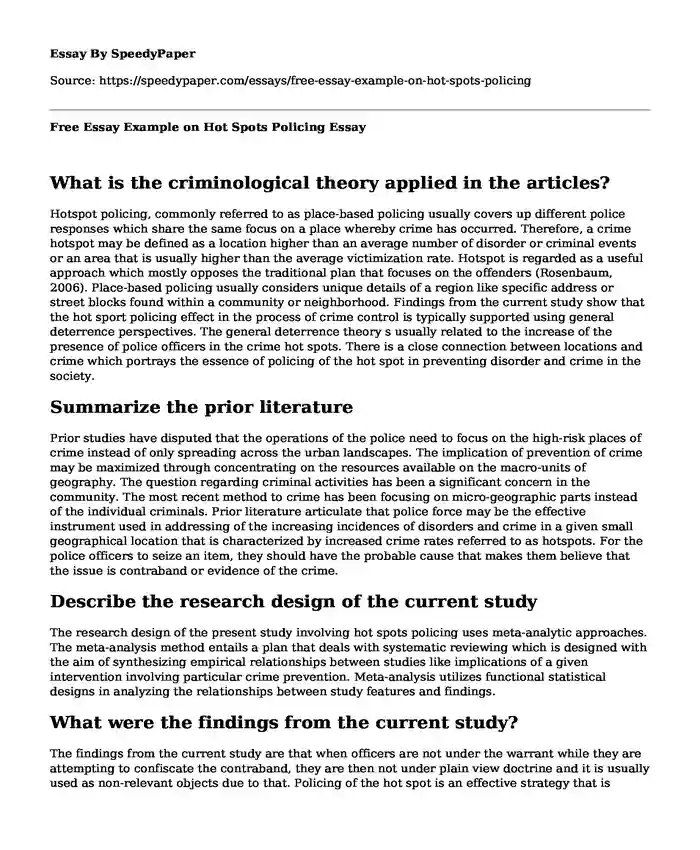What is the criminological theory applied in the articles?
Hotspot policing, commonly referred to as place-based policing usually covers up different police responses which share the same focus on a place whereby crime has occurred. Therefore, a crime hotspot may be defined as a location higher than an average number of disorder or criminal events or an area that is usually higher than the average victimization rate. Hotspot is regarded as a useful approach which mostly opposes the traditional plan that focuses on the offenders (Rosenbaum, 2006). Place-based policing usually considers unique details of a region like specific address or street blocks found within a community or neighborhood. Findings from the current study show that the hot sport policing effect in the process of crime control is typically supported using general deterrence perspectives. The general deterrence theory s usually related to the increase of the presence of police officers in the crime hot spots. There is a close connection between locations and crime which portrays the essence of policing of the hot spot in preventing disorder and crime in the society.
Summarize the prior literature
Prior studies have disputed that the operations of the police need to focus on the high-risk places of crime instead of only spreading across the urban landscapes. The implication of prevention of crime may be maximized through concentrating on the resources available on the macro-units of geography. The question regarding criminal activities has been a significant concern in the community. The most recent method to crime has been focusing on micro-geographic parts instead of the individual criminals. Prior literature articulate that police force may be the effective instrument used in addressing of the increasing incidences of disorders and crime in a given small geographical location that is characterized by increased crime rates referred to as hotspots. For the police officers to seize an item, they should have the probable cause that makes them believe that the issue is contraband or evidence of the crime.
Describe the research design of the current study
The research design of the present study involving hot spots policing uses meta-analytic approaches. The meta-analysis method entails a plan that deals with systematic reviewing which is designed with the aim of synthesizing empirical relationships between studies like implications of a given intervention involving particular crime prevention. Meta-analysis utilizes functional statistical designs in analyzing the relationships between study features and findings.
What were the findings from the current study?
The findings from the current study are that when officers are not under the warrant while they are attempting to confiscate the contraband, they are then not under plain view doctrine and it is usually used as non-relevant objects due to that. Policing of the hot spot is an effective strategy that is needed in reducing of the opportunities in offenses since it is different from arresting of offenders using the traditional approach
What is the significance or relevance of the current study to modern day society?
The plain view doctrine is significant in the daily life since there are more dangerous individuals out in today world. The contraband requires being put in the plain sight to enable the officer to confiscate the contraband anywhere near the person. Evidence usually suggest that the hot spot policing has minimized crime. The programs of hot spot policing which assume an issue-oriented strategy typically appear to be more useful for the violent crimes, disorders and drug offenses than when compared to the property crime. Thus hot spot policing has the potential of leading a given case to the diffusion of several benefits to the parts that are immediately surrounding the hot spot region. There are various considerations which opt to be given the priority regarding the kind of activity which is applied which is usually determined by the nature of the issue surrounding the hot spot.
Hotspot policing involves a strategy whereby the targeting of activities an resources to those locations where the crime of mainly concentrated. This kind of approach is usually based on a premise which disorder and crime are not uniformly spread within the neighborhoods although it is clustered in the small parts. Therefore, concentrating on activities and resources in the hot spots is typically aimed at preventing crime in these unique regions and potentially minimize overall levels of crimes in more extensive geographical parts.
References
Rosenbaum, D. P. (2006). The limits of hot spots policing. Police innovation: Contrasting perspectives, 245-263.
Cite this page
Free Essay Example on Hot Spots Policing. (2022, Jul 13). Retrieved from https://speedypaper.com/essays/free-essay-example-on-hot-spots-policing
Request Removal
If you are the original author of this essay and no longer wish to have it published on the SpeedyPaper website, please click below to request its removal:
- Circular Flow Model - Economics Essay Example
- Free Essay on Food Consumption Factors
- Essay Sample in US History: Most Important Changes in the US in 1877-1945
- Essay Example: Social Constructionist Approaches
- Comparison Essay Sample: Baraka's Poetry Between the Beat and Islamic Phase
- Essay Example on Gender Stereotyping in Aristophanes' Play Lysistrata
- Free Essay: Mental Health a Major Concern Among the Youth Today
Popular categories





